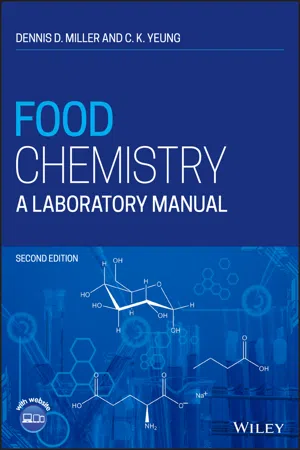
- English
- ePUB (mobile friendly)
- Available on iOS & Android
About this book
A manual designed for Food Chemistry Laboratory courses that meet Institute of Food Technologists undergraduate education standards for degrees in Food Science
In the newly revised second edition of Food Chemistry: A Laboratory Manual, two professors with a combined 50 years of experience teaching food chemistry and dairy chemistry laboratory courses deliver an in-depth exploration of the fundamental chemical principles that govern the relationships between the composition of foods and food ingredients and their functional, nutritional, and sensory properties. Readers will discover practical laboratory exercises, methods, and techniques that are commonly employed in food chemistry research and food product development.
Every chapter offers introductory summaries of key methodological concepts and interpretations of the results obtained from food experiments. The book provides a supplementary online Instructor's Guide useful for adopting professors that includes a Solutions Manual and Preparation Manual for laboratory sessions.
The latest edition presents additional experiments, updated background material and references, expanded end-of-chapter problem sets, expanded use of chemical structures, and:
- A thorough emphasis on practical food chemistry problems encountered in food processing, storage, transportation, and preparation
- Comprehensive explorations of complex interactions between food components beyond simply measuring concentrations
- Additional experiments, references, and chemical structures
- Numerous laboratory exercises sufficient for a one-semester course
Perfect for students of food science and technology, Food Chemistry: A Laboratory Manual will also earn a place in the libraries of food chemists, food product developers, analytical chemists, lab technicians, food safety and processing professionals, and food engineers.
Frequently asked questions
- Essential is ideal for learners and professionals who enjoy exploring a wide range of subjects. Access the Essential Library with 800,000+ trusted titles and best-sellers across business, personal growth, and the humanities. Includes unlimited reading time and Standard Read Aloud voice.
- Complete: Perfect for advanced learners and researchers needing full, unrestricted access. Unlock 1.4M+ books across hundreds of subjects, including academic and specialized titles. The Complete Plan also includes advanced features like Premium Read Aloud and Research Assistant.
Please note we cannot support devices running on iOS 13 and Android 7 or earlier. Learn more about using the app.
Information
1
Acids, Bases, and Buffers
1.1 Learning Outcomes
- Explain the roles of acids and bases in food products.
- Measure the pH of selected food products.
- Prepare and evaluate a buffer system.
- Measure the buffering capacity of a common beverage.
1.2 Introduction
1.2.1 Acids
| Substance | Structure | pKa | Food found in |
|---|---|---|---|
| Acetic acid |  | pK = 4.75 | Vinegar, figs |
| Adipic ... |
Table of contents
- Cover
- Table of Contents
- Title Page
- Copyright Page
- Preface to the Second Edition
- Preface to the First Edition
- Acknowledgments
- About the Companion Website
- 1 Acids, Bases, and Buffers
- 2 Chemical Leavening Agents
- 3 Properties of Sugars
- 4 Nonenzymatic Browning
- 5 Food Hydrocolloids
- 6 Functional Properties of Proteins
- 7 Lactose
- 8 Enzymatic Browning
- 9 Blanching Effectiveness
- 10 Lipid Oxidation
- 11 Ascorbic Acid
- 12 Hydrolytic Rancidity in Milk
- 13 Caffeine in Beverages
- 14 Color Additives
- 15 Plant Pigments
- 16 Meat Pigments
- 17 Meat Tenderizers
- 18 Detection of Genetically Engineered Maize Varieties
- 19 Food Emulsions and Surfactants
- Appendix I: Conversion Factors
- Appendix II: Concentration
- Appendix III: Acids, Bases, Buffers, and pH Measurement
- Appendix IV: Spectrophotometry
- Appendix V: Chromatography
- Appendix VI: Electrophoresis
- Appendix VII: Glossary
- End User License Agreement